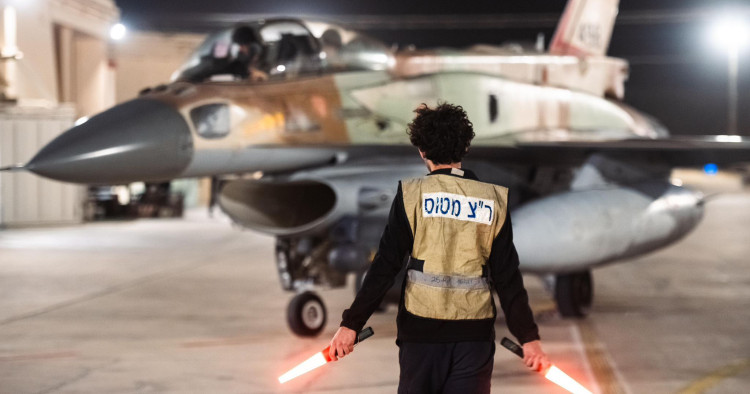Contents:
- Following Israeli counterstrike on Iran, region appears to pull back from the brink
- Israeli strikes put Iran’s "forward defense" regional proxy strategy under the microscope
- Scheduled high-level Gaza cease-fire talks underway in Qatar, though the parties haven’t budged
- Pakistan’s political establishment clips the wings of a troublesome judiciary
Following Israeli counterstrike on Iran, region appears to pull back from the brink
Paul Salem
Vice President for International Engagement

-
The Israeli decision to limit its retaliatory strike and lower the risk of further escalation with Iran has raised hopes that, after more than a year of war, perhaps Prime Minister Benjamin Netanyahu is winding down this round of warfare; this has renewed diplomatic efforts to bring the wars in Gaza and Lebanon to a close.
-
The more immediate prospect is a cease-fire in Lebanon, with Hezbollah signaling — perhaps following back-channel talks with Iran— that its forces are ready to withdraw north of the Litani River; US envoy Amos Hochstein is shuttling back and forth trying to secure a deal.
After last weekend’s limited Israeli strike on Iran, and Tehran’s apparent willingness to absorb the blow without serious retaliation, the Middle East region looks to be pulling back from the brink of a major regional war. Credit must be given to the US administration, which worked hard to convince the Israeli government to not hit nuclear and energy targets as well as avoid a strike so large that it would necessitate an Iranian retaliation. The Israeli decision to choose a path that would avert further escalation with Iran has raised hopes that, after more than a year of war, perhaps Prime Minister Benjamin Netanyahu is winding down this round of warfare.
Most immediately, the current situation has renewed international efforts to bring the (linked) wars in Gaza and Lebanon to a close and progress toward negotiated solutions in both conflicts. In Lebanon, allies of Hezbollah are insisting that it, and what exists of the Lebanese government, are ready to implement United Nations Security Council (UNSC) Resolution 1701. This would include a cease-fire (separate from one in Gaza), a withdrawal of Hezbollah forces north of the Litani River, and a more serious redeployment of a strengthened Lebanese Army as well as the UN Interim Force in Lebanon (UNIFIL) to that area. Israel is insisting on additional conditions, but US envoy Amos Hochstein is shuttling between both capitals trying to secure a deal. In Gaza, a final cease-fire might still be a ways away, yet talks are zeroing in on at least short pauses in the fighting to release small batches of Israeli hostages and Palestinian detainees.
A large question circulating around the region is what concessions, if any, did Iran offer in back channels to the United States or other mediators, to ensure a more limited strike than what Israeli leaders seemed to be signaling a couple of weeks ago. One indication might be the position that Hezbollah is communicating to its allies, as mentioned above. Tehran may have also committed to limit or curtail the resupply of major weaponry to a lingering Hezbollah. It is hard to imagine that Hochstein would carry a proposal to Israel that only contains a withdrawal of Hezbollah from the border area, if he hasn’t also banked some commitments regarding the future military capacities and deployments of the Lebanese armed group. After 2006, Hezbollah came back much stronger than before; Israel has vowed not to repeat that experience. Tehran also might have set a conciliatory tone to be well positioned to avoid major negative repercussions vis-à-vis Washington, and/or to take advantage of negotiation opportunities, once a new president is elected in the US.
Just a few days ago, many around the region feared that the wars in Gaza and Lebanon were just a prelude to a major and decisive showdown between Israel and Iran, which could engulf the Gulf and more. Today, diplomacy and efforts to find a pathway out of this multiple-front war are being given another chance.
Follow: @paul_salem
Israeli strikes put Iran’s “forward defense” regional proxy strategy under the microscope
Alex Vatanka
Director of Iran Program and Senior Fellow, Black Sea Program

-
More time is needed to gauge whether Israel’s Oct. 26 attack on strategic military and defense-industrial sites in Iran might shift the strategic calculations of the two sides; but clearly, the taboo against direct war between them is firmly and definitively broken.
-
Despite Iran’s vaunted deterrence strategy based on proxy forces arrayed around the region, Israel just used an air corridor over Lebanon, Syria, and Iraq to hit targets in the Iranian capital; and no official in Tehran can sugarcoat this stark new reality.
The scale of the damage from Israel’s Oct. 26 attack against a number of strategic military and defense-industrial sites in Iran is still to be determined. At the moment, Israel and Iran remain engaged in battle of words to assert their respective positions and capacities to harm each other going forward. But more time is needed to gauge whether the attack might shift the strategic calculations of the two sides. One certainty, however, is that the taboo against direct war between Iran and Israel is firmly and definitively broken. This reality alone will surely focus the minds of policymakers in both countries.
For its part, Israel claims to have “restrained” itself and that its “hours-long bombardment” of various sites around Iran was only a sample of its firepower. Iranian officials have downplayed the Israeli strikes that left five Iranians dead. The attack “has not had the slightest effect on Iran’s military power,” according to the secretary of Iran’s Supreme National Security Council. But that sort of dismissal runs counter even to the assessment of Supreme Leader Ayatollah Ali Khamenei, who cautioned that Israel’s attack “should not be exaggerated or minimized.”
Khamenei’s early statements signal he has concerns about a sense of complacency among his ranks but also needless bravado. Still, he has not yet shown a clarity of intent as far as Iran’s possible response is concerned. Khamenei urging against baseless swagger reflects a tendency among officials in the Islamic Republic to soft-peddle the military threat that Israel poses. One military official was quickly “corrected” for making the claim that Iran had withstood “600 missiles” fired by Israel, a case of self-defeating braggadocio.
What no one can deny is that last weekend marked the first time Israel had openly attacked Iran whereas before it might have (temporarily) avoided claiming official responsibility or sought some space for deniability by resorting to assassinations, cyberattacks, and other non-kinetic operations. It has taken 45 years, since the Islamic Republic was born, but Iran and Israel are now no longer able to limit their conflict to a fight by proxy in places like Lebanon or Syria. The Israeli attack puts Iran’s “forward defense” strategy under the microscope unlike any time before. In the last decade, many commentators have spoken about the land bridge from Iran to the Mediterranean and how Tehran’s reach extended all the way to Israel. Israel just used an air corridor over Lebanon, Syria, and Iraq to hit targets in the Iranian capital. No official in Tehran can sugarcoat this stark new reality.
For his part, Khamenei has so far opted not to demand swift retaliation, as he did when Israel attacked the Iranian consulate in Damascus on April 1 or when it killed Hezbollah leader Hassan Nasrallah on Sept. 27. Khamenei has instead asked “Iranian officials to determine” how to respond to Israel. This ambiguity is not surprising. Khamenei is not exactly a gambler, and he surely knows that when it comes to managing the Iranian-Israeli conflict, the stakes have never been higher.
Follow: @AlexVatanka
Scheduled high-level Gaza cease-fire talks underway in Qatar, though the parties haven’t budged
Paul Scham
Non-Resident Scholar

-
As the talks in Doha restart, no breakthrough is expected, given that the Israeli and Hamas positions have remained fundamentally unchanged for months.
-
Despite the success of Israel’s long-anticipated airstrikes on Iranian defense facilities, Israelis are by no means rallying around the current strategy, as demonstrations in favor of an immediate hostage-release deal continue around the country.
Most attention since Friday night (Saturday morning, local time) has been focused on the aftermath of the long-anticipated Israeli airstrikes on Iranian defense facilities, in response to Iran’s salvo of 180 ballistic missiles against Israel on Oct. 1. Correspondingly little is seemingly being paid to the high-level talks in Qatar that began on Sunday afternoon, which include Central Intelligence Agency (CIA) chief William Burns and Mossad head David Barnea, as well as Qatari Prime Minister Sheikh Mohammed bin Abdulrahman bin Jassim Al Thani. As the Doha talks were getting underway, Egyptian President Abdel-Fattah el-Sisi proposed, at a press conference in Cairo, a previously bruited two-day cease-fire in order to exchange four Israeli hostages of the 101 thought to be held by Hamas for “some” Palestinian prisoners held by Israel. This would be followed by 10 days of intensive negotiations aimed at achieving a longer cease-fire.
However, all indications are that Hamas is sticking to its long-time demand for a single comprehensive deal involving the release of all hostages in exchange for Palestinian prisoners and a full Israeli withdrawal from Gaza. Though Hamas is not participating in the Doha talks, it said it would study the proposal; no breakthrough is expected, however, given that the Israeli and Hamas positions have remained fundamentally unchanged for months.
Nevertheless, Barnea remained in Qatar overnight, and the cease-fire and hostage-release negotiations continued on Monday.
Despite reports that dozens of Palestinians were killed or wounded in northern Gaza on Saturday night, world attention has been focused primarily on Israel’s missile exchange with Iran. Iran has claimed minimal damage from the strikes, while Israel proclaimed that it had taken out the command-and-control site for Iranian air defense, as well as those for Syria and Iraq, enabling Israeli aircraft to overfly them without permission on their way to attack Iran. The clear implication that Iran is therefore open to Israeli attack at any future time is not lost on anyone.
Despite the apparent Israeli victory lap and Prime Minister Benjamin Netanyahu’s rise in popularity in the last few weeks, Israelis are by no means rallying around the current strategy. Defense Minister Yoav Gallant has demanded “a discussion and an update of the war objectives,” while relatives of the hostages and their supporters demonstrated around Israel in favor of an immediate deal to free them.
There is no indication of any change in the opposition of leading Israeli government ministers Itamar Ben-Gvir and Bezalel Smotrich to any agreement to limit Israeli military activity. Thus, there appears to be little reason for optimism regarding the current talks, despite their high level.
Pakistan’s political establishment clips the wings of a troublesome judiciary
Marvin G. Weinbaum
Director, Afghanistan and Pakistan Studies

-
Pakistan’s ruling coalition has cobbled together a parliamentary super-majority needed to pass a constitutional amendment designed to tame the judiciary by giving the government greater control over appointments to the Supreme Court.
-
A large body of lawyers in the country in alliance with Imran Khan’s opposition Tehreek-e-Insaf party has threatened to initiate massive protests against the 26th Amendment, which may push Pakistan, already mired in political turmoil, into a full-blown judicial crisis.
The higher judiciary has been a constant thorn in the side of Pakistan’s ruling party coalition in its efforts to fully consolidate power and politically stifle populist Imran Khan and his Tehreek-e-Insaf (PTI) party. The judges have been criticized by the government for their allegedly excessive involvement in governmental affairs and repeated rulings favorable to Khan and the opposition party. The institutional clash peaked in July, when an eight-member majority of the Supreme Court’s judges ruled in favor of the PTI in a dispute over the reallocation of reserved parliamentary seats that had been awarded to the ruling coalition after the Feb. 8, 2024, general elections. Needing a two-thirds vote within the legislature to pass constitutional amendments, the government maneuvered politically to ignore the highest court’s decision and, on Oct. 21, with the defection of several opposition party legislators, cobbled together the majority to pass a 26th Amendment designed to tame the judiciary.
With passage of the constitutional amendment, the government captured greater control over appointments to the Supreme Court. This was immediately on display with the controversial appointment of Pakistan’s 30th chief justice. Under the newly created provisions, the prime minister, advised by a 12-member parliamentary committee, can now appoint a chief justice regardless of seniority — a significant shift from past practice. Other top judges will be appointed by a judicial commission that includes lawmakers. Newly designated benches of judges charged with handling constitutional and political cases will also receive legislative oversight. This expansion of the legislature’s involvement in judicial appointments has prompted serious concerns over judicial independence and the integrity of Pakistan’s justice system.
The ruling coalition defends this move as necessary to rebalance power between the courts and parliament; its leaders are celebrating the latest constitutional amendment as a win for democracy and an end to “judicial dictatorship.” They argue that the judiciary has historically acted against democratic governments and in alignment, albeit not recently, with the military establishment. Critics, however, see the amendment as politicizing judges, compromising the impartiality of the court system and its ability to check political elites. They contend that placing judges under legislative influence undermines meritocracy, promotes favoritism, and risks creating a judiciary more sympathetic toward government interests than justice itself.
Newly appointed Chief Justice Yahya Afridi, who has pledged to uphold the rule of law and protect the dignity of judges and the authority of the court, faces significant challenges from escalating internal divisions within the legal community. As constitutional benches are to be formed with separate judges presiding over them, it is as yet unclear who will wield greater authority, the judges presiding over the benches or the chief justice, especially considering that, henceforth, chief justices are stripped of their previous exercise of suo motu (on his own initiative) powers. Additionally, it remains to be seen how effectively the judiciary will function under Afridi’s leadership, given that two senior judges, once colleagues, are now positioned as his subordinates.
Meanwhile, a large body of lawyers in the country in alliance with the PTI has threatened to initiate massive protests against the 26th Amendment; its demonstrations would be reminiscent of 2007, when a lawyers’ movement succeeded in forcing then President-cum-General Pervez Musharraf to restore to office a popular chief justice he had ousted. If a similar movement materializes, it could lead to significant disruptions of the justice system. With Pakistan already mired in political turmoil, the country could succumb to a full-blown judicial crisis that puts its political stability at risk.
Research assistant Naade Ali contributed to this piece.
Follow: @mgweinbaum
Photo by Israel Defense Forces (IDF) / Handout/Anadolu via Getty Images
The Middle East Institute (MEI) is an independent, non-partisan, non-for-profit, educational organization. It does not engage in advocacy and its scholars’ opinions are their own. MEI welcomes financial donations, but retains sole editorial control over its work and its publications reflect only the authors’ views. For a listing of MEI donors, please click here.













